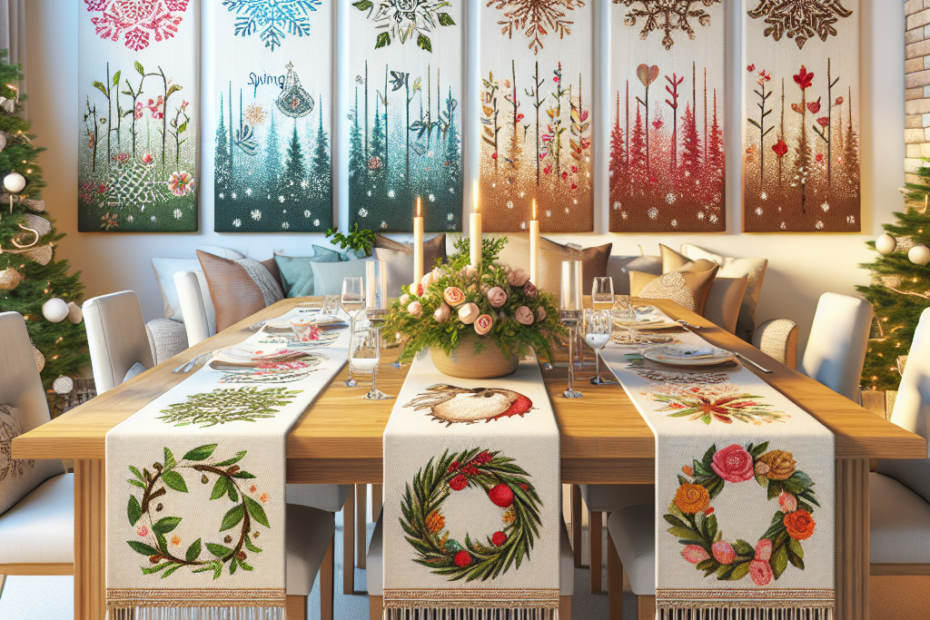DIY Table Runners for a Festive Dining Room
Many people enjoy DIY projects, especially when they can add a personal touch to their home decor. Table runners are an excellent way to bring a festive feel to a dining room, and they can be made easily and inexpensively. In this blog, everyone can learn how to create DIY table runners that will make their dining space look inviting and special. Let’s dive into some creative ideas and easy steps for creating stunning DIY table runners for any occasion.
Why DIY Table Runners?
DIY table runners are popular because they allow for personalization and creativity. According to a survey by Statista in 2022, 40% of respondents said they engage in DIY activities to save money, and 38% do it for personal satisfaction. Table runners can be made from various materials and designs to suit different themes and seasons, making them a versatile choice for home decor.
Materials Needed
Before starting a DIY table runner, gather the necessary materials. Here’s a list of common supplies:
- Fabric (cotton, linen, burlap, etc.)
- Scissors
- Measuring tape
- Fabric glue or sewing machine
- Decorative elements (ribbons, lace, beads, etc.)
- Iron and ironing board
Steps to Make a Simple Fabric Table Runner
1. Measure the Table: Measure the length and width of the dining table. A table runner should hang about 6-12 inches over each end of the table.
2. Cut the Fabric: Based on the measurements, add an extra inch on all sides for hemming. Cut the fabric accordingly.
3. Hem the Edges: Fold the edges of the fabric by half an inch, then fold again and iron to create a neat hem. Sew or glue the hems in place.
4. Add Decorations: Choose decorative elements like ribbons, lace, or beads. Sew or glue them onto the fabric to give the table runner a festive look.
5. Final Touches: Iron the table runner to remove any wrinkles and lay it on the table to ensure it fits well.
Creative DIY Table Runner Ideas
| Idea | Description | Materials |
|---|---|---|
| Burlap Table Runner | Burlap gives a rustic and festive look. | Burlap fabric, lace, fabric glue |
| Stenciled Table Runner | Use stencils to paint festive designs. | Plain fabric, fabric paint, stencils |
| Patchwork Table Runner | Combine different fabric scraps for a colorful look. | Various fabric scraps, sewing machine |
| Beaded Table Runner | Attach beads for an elegant touch. | Beads, needle, and thread |
Care and Maintenance
Taking proper care of a DIY table runner ensures it lasts longer and stays in good condition. Here’s how to care for them:
- Hand wash or use a gentle cycle in the washing machine with mild detergent.
- Avoid bleach and strong chemicals that could damage the fabric and decorations.
- Air dry to preserve the shape and prevent shrinking.
- Iron on a low heat setting to remove wrinkles.
Key Takeaways
- DIY table runners are a cost-effective and personalized way to decorate the dining room.
- Various materials and designs enable creativity and adaptation to different themes.
- Essential supplies include fabric, scissors, measuring tape, and decorative elements.
- Proper care and maintenance extend the life and appearance of a DIY table runner.
- Simple steps for creating a table runner include measuring, cutting fabric, hemming, and adding decorations.
FAQs
- 1. What is the best fabric for a DIY table runner?
- Common choices include cotton, linen, and burlap, as they are easy to work with and provide different looks.
- 2. Can I make a no-sew table runner?
- Yes, simply use fabric glue for the hems and decorations instead of sewing.
- 3. How long should a table runner be?
- A table runner should typically hang about 6-12 inches over each end of the table.
- 4. How can I make my table runner look more festive?
- Incorporate seasonal or holiday-themed decorations like ribbons, lace, beads, or stenciled designs.
- 5. How do I clean my DIY table runner?
- Hand wash or use a gentle machine cycle, air dry, and iron on low heat to maintain its quality.
